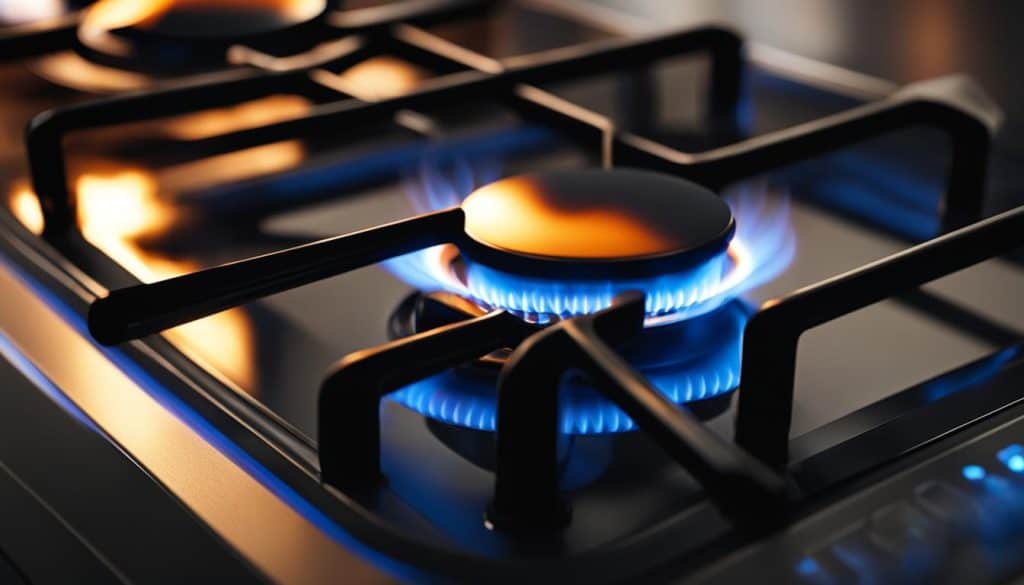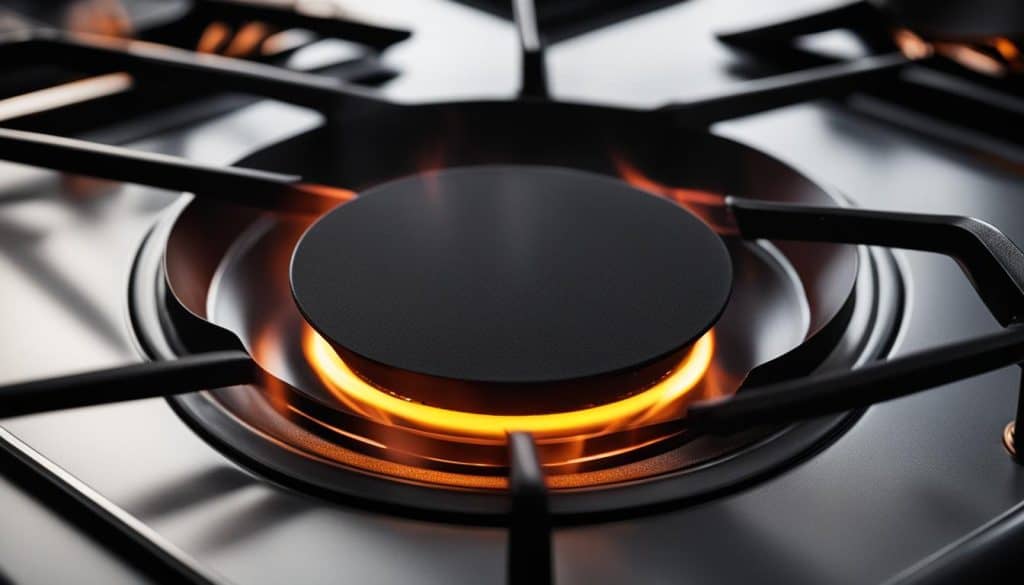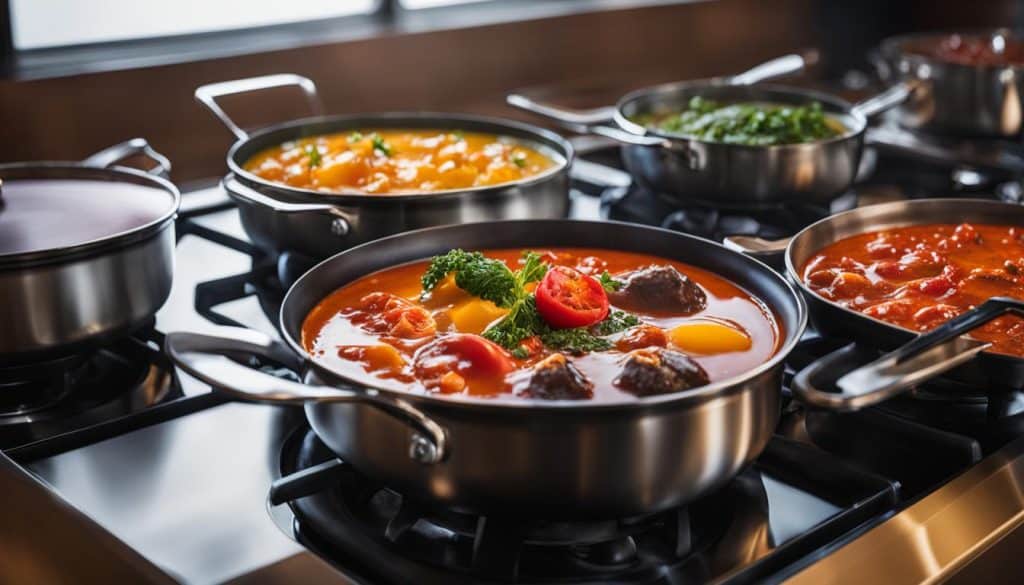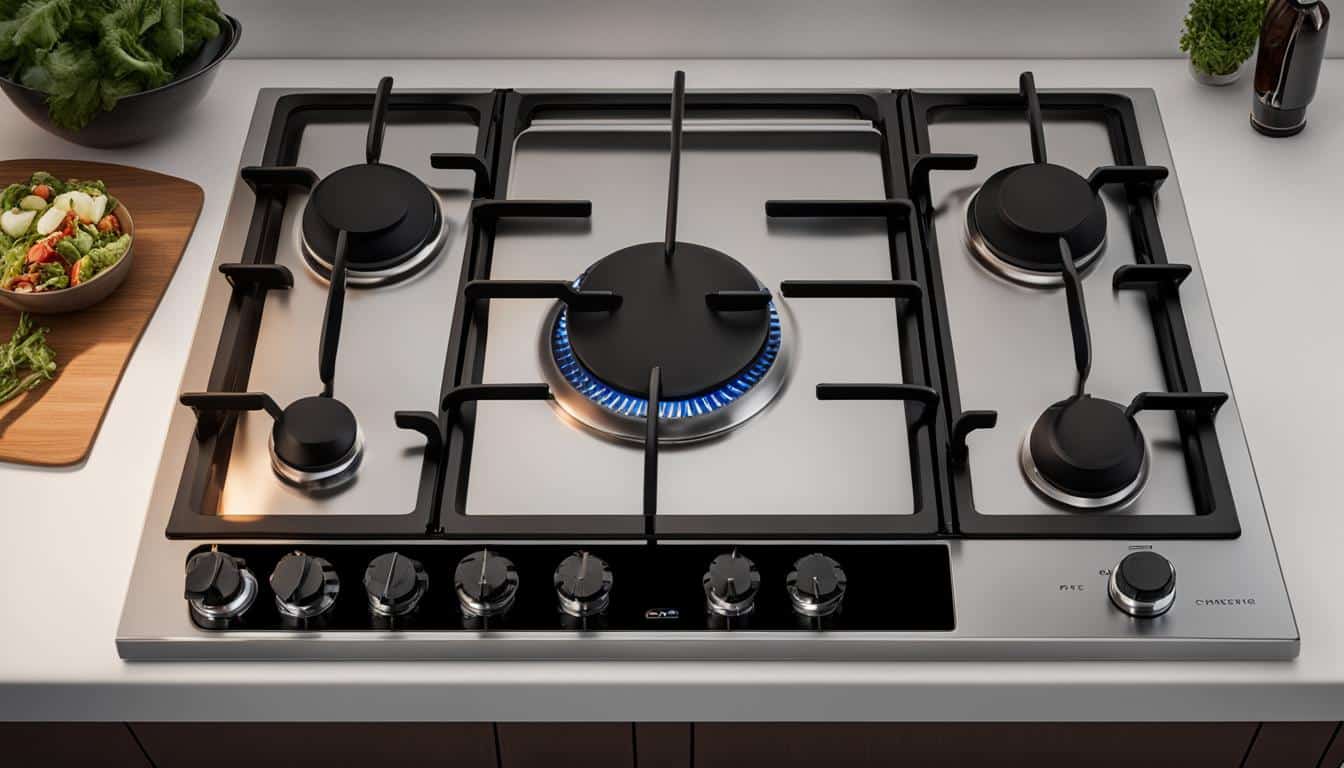If you’re serious about your culinary game, mastering the art of simmering is an essential skill to have in your kitchen arsenal. And with gas cooktop simmer control, achieving the perfect simmer is easier than ever before.
Gas cooktop simmer control is an innovative feature that regulates gas flow, allowing for a low, steady flame ideal for simmering. With this feature, you can eliminate the risk of burning or scorching delicate dishes, achieve perfect texture and consistency for simmered foods, and enhance flavor development.
If you’re not familiar with simmer control, don’t worry. In this section, we’ll introduce you to gas cooktop simmer control and explain its function. We’ll also touch upon the various types of simmer control mechanisms available in gas cooktops, giving you the tools you need to take your cooking to the next level.
Understanding Gas Cooktop Simmer Control
Gas cooktop simmer control is a feature that allows you to regulate the gas flow to achieve a low, steady flame. This is especially useful when simmering delicate dishes like sauces or soups. But how does it differ from standard gas burner controls? Let’s explore.
Gas burner controls typically have a range of heat settings, but the low setting may still be too high for simmering. Simmer control, on the other hand, provides a much finer adjustment to the flame level, allowing for a gentle simmer without the risk of burning or scorching.
There are different types of simmer control mechanisms available, including simmer plates and dual-stacked burners. Simmer plates are flat disks that sit on top of the burner and distribute heat evenly across the bottom of your pot or pan. Dual-stacked burners have two sets of flames, one large and one small, allowing for greater control over the heat output.
| Simmer Control Type | Description |
|---|---|
| Simmer Plates | Flat disks that sit on top of the burner and distribute heat evenly across the bottom of your pot or pan. |
| Dual-Stacked Burners | Have two sets of flames, one large and one small, allowing for greater control over the heat output. |
| Other Types | Some gas cooktops use other mechanisms for simmer control, such as adjustable vents or specialized burner heads. |
Understanding the different types of simmer control mechanisms is essential for effectively using simmer control in your everyday cooking. In the next section, we’ll provide step-by-step instructions on how to use simmer control effectively.
Mastering Simmer Control: Using it Effectively
Adjusting simmer control on your gas cooktop can be a game-changer for achieving perfect simmering results. It allows you to regulate the gas flow and maintain a low, steady flame, which is crucial for simmering delicate foods and achieving the desired texture and consistency. Here are some step-by-step instructions for using simmer control effectively:
Adjusting Simmer Control: Flame Size and Heat Level
The ideal flame size and heat level for simmering depend on the food you’re cooking. Here are some basic guidelines:
- Small Flames: Use a small flame for delicate foods that require gentle cooking, such as sauces and custards.
- Medium Flames: Use a medium flame for slightly heartier foods that still require gentle cooking, such as soups and stews.
- Large Flames: Use a large flame for heartier foods that can handle stronger cooking, such as pasta sauces and chili.
Keep in mind that simmering is different from boiling, which requires a higher heat level and larger bubbles. If you’re unsure, start with a small flame and adjust as needed.
Troubleshooting Common Issues
If you notice uneven heating or flame instability while simmering, there are a few things you can do:
- Simmer Plates: Consider using a simmer plate, which evenly distributes heat and allows for better temperature control. Simmer plates are especially useful for small pots or when using a gas range with large flames.
- Diffuser Discs: A diffuser disc can also help distribute heat more evenly and prevent hot spots.
- Pot Placement: Make sure your pot is centered on the burner and flat on the cooktop surface. Uneven pots or warped pans can cause uneven heating.
- Adjustment: If the flame keeps going out, adjust the simmer control to a slightly higher setting.
Cleaning and Maintaining Simmer Control
Clean your gas cooktop regularly to ensure optimal performance and longevity. Here are some tips:
- Regular Cleaning: Wipe down the cooktop after each use with a damp cloth. Clean deeper once a week with a gentle cleaner and soft sponge, taking care not to scratch the surface.
- Simmer Plates: If you’re using simmer plates, clean them after each use to prevent buildup and ensure even heating.
- Maintenance: If you notice any issues with your simmer control, have a professional technician inspect it and perform any necessary repairs.
With these tips, you’ll be able to master the art of simmering on your gas cooktop, achieving perfect results every time.

Enhancing Your Simmering Technique: Tips and Tricks
Simmering is a delicate cooking technique that requires precision and attention to detail. To enhance your simmering technique, you need to consider the cookware you’re using, the timing, and other factors that can affect the outcome of your dishes. Here are some tips and tricks to help take your simmering game to the next level.
Choosing Cookware
When it comes to simmering, choosing the right cookware is key. You want a heavy-bottomed pot that can distribute heat evenly and prevent scorching. A tight-fitting lid is also essential to trap steam and prevent evaporation, allowing your food to simmer in its own juices.
You can also consider using a non-stick pan or a Dutch oven for simmering. Non-stick pans are great for dishes that require frequent stirring, while Dutch ovens are perfect for stews and braises that need to cook for an extended period.
Using a Timer
Simmering requires patience and precise timing. Using a timer can help ensure that your food is simmered for the correct duration. To find the ideal simmering time for your dishes, experiment with different settings and keep track of the time it takes to achieve the desired results.
Incorporating Simmer Control into your Everyday Cooking Routines
Simmer control can be a valuable tool in your everyday cooking routines. For example, you can use it to keep soups and stews warm without overcooking them. You can also use simmer control to reheat leftovers or to cook grains like rice and quinoa. By incorporating simmer control into your cooking, you can achieve consistent results and reduce the risk of burning or overcooking your food.
Controlled Simmering and Low-Temperature Cooking
Controlled simmering and low-temperature cooking are advanced techniques that can help you achieve exceptional results with your simmered dishes. Controlled simmering involves maintaining a consistent temperature t oughout the cooking process, while low-temperature cooking involves cooking at temperatures between 120-180°F. Both techniques are ideal for delicate foods that require slow, gentle cooking, such as custards, sauces, and soups.
Using these tips and tricks, you can master the art of simmering and take your culinary game to the next level. Whether you’re simmering sauces, soups, or stews, these techniques will help you achieve perfect results every time.
Common Mistakes When Simmering
Simmering is a delicate culinary game that requires precision and patience. However, even the most experienced chefs make mistakes. Here are some common mistakes to avoid when simmering:
- Boiling instead of simmering: One of the most common mistakes is confusing boiling with simmering. Boiling is when the liquid reaches its highest temperature and begins to bubble rapidly. Simmering, on the other hand, is when the liquid is heated just below boiling, with small bubbles occasionally appearing on the surface. To avoid boiling, adjust the heat and make sure that the temperature does not exceed the recommended range for simmering.
- Not adjusting the simmer control: Gas cooktops equipped with simmer control mechanisms are designed to regulate gas flow for a low, steady flame. Neglecting to use these controls can result in uneven heating or burning. Make sure to adjust the simmer control when needed to achieve the desired heat level.
- Overcrowding the pot: Overcrowding the pot can cause uneven cooking, making it difficult to achieve the desired texture and consistency. It’s essential to use the right pot size for the amount of food you are simmering and to avoid overcrowding.
- Not stirring enough: Stirring is crucial when simmering to prevent the food from sticking to the bottom of the pot and to ensure that the flavors are evenly distributed. Make sure to stir regularly, especially when cooking sauces and soups.
- Adding ingredients too quickly: Adding ingredients too quickly can reduce the temperature of the liquid, causing it to stop simmering. To avoid this, add ingredients gradually and stir well between each addition.
- Not using a lid: Using a lid helps to trap heat and moisture, resulting in faster and more even cooking. Make sure to use a lid that fits tightly to prevent steam from escaping. However, be careful not to cover the pot completely, as this may raise the temperature too much and cause boiling.
By avoiding these common mistakes, you can master the art of simmering and create delicious, perfectly-cooked dishes every time.

Cleaning and Maintaining Gas Cooktop Simmer Control
To keep your gas cooktop simmer control performing optimally and ensure its longevity, regular cleaning and maintenance are essential. Follow these simple steps to keep your simmer control in top condition:
Cleaning Your Simmer Control
For routine cleaning, use a soft cloth or sponge with warm, soapy water and wipe down the simmer control dial, base, and grates. Be sure to avoid abrasive cleansers, scrub pads, or harsh chemicals as they may scratch or damage the surface.
If your simmer control has accumulated stubborn stains or grease buildup, try a specialized cooktop cleaner. Apply the cleaner to the simmer control and surrounding areas, let it sit for a few minutes, and then wipe away with a non-abrasive cloth or sponge. Rinse with water and dry with a clean, soft cloth.
Maintaining Your Simmer Control
Regular maintenance of your simmer control will ensure its reliable operation and longevity. Here are some key tips:
- Check your simmer control periodically for any loose or damaged parts. If you notice anything out of place, tighten or replace the part immediately.
- Clear away any debris or food particles that may have accumulated around the simmer control and gas burners, as these can negatively impact their operation.
- If you notice any issues with your simmer control, such as difficulty adjusting the flame size or uneven heating, consult your appliance manual or a professional for troubleshooting and repairs.
With these simple cleaning and maintenance tips, you can keep your gas cooktop simmer control functioning smoothly and efficiently for years to come.

Gas Cooktop Features for Enhanced Cooking
Gas cooktops offer a range of features and functionalities to enhance your cooking experience. By understanding and utilizing these features, you can take your culinary game to the next level.
High BTU Burners
Gas cooktops with high BTU (British Thermal Units) burners deliver greater heat output, making them ideal for searing, boiling, and stir-frying. They also reduce cooking time, providing you with more time to enjoy your meal. However, keep in mind that higher heat also means increased energy consumption.
Griddle and Grill Plates
Griddle and grill plates are perfect for preparing pancakes, bacon, meat, and vegetables. They provide more cooking space and eliminate the need for additional cookware. The plates are easy to clean and maintain. Complement your gas cooktop with a griddle or grill plate and enjoy delicious grilled or griddled meals.
Wok Rings
Wok rings are designed to support a wok while cooking, providing stability and ensuring even heat distribution. They are ideal for preparing stir-fry meals and other dishes that require high-heat cooking. Wok rings make wok cooking convenient and enjoyable.
Simmer Plates and Dual-Stacked Burners
Simmer plates and dual-stacked burners support low, steady flames, making them ideal for simmering soups, sauces, and stews. These features provide greater temperature control and prevent delicate dishes from burning or scorching. They also enhance flavor development and ensure perfect texture and consistency.
Continuous Grates
Continuous grates provide a smooth, uninterrupted surface that makes it easy to move pots and pans around. They also provide stability for larger cookware and reduce the risk of spillage. Continuous grates are typically made of durable materials that are easy to clean and maintain.

Take advantage of your gas cooktop’s features and create delicious meals with ease. Whether it’s high BTU burners, griddle and grill plates, wok rings, simmer plates and dual-stacked burners, or continuous grates, gas cooktops offer a range of features that make cooking more convenient and enjoyable.
Exploring Simmering Techniques: Sauces, Soups, and Stews
Now that you have a solid understanding of gas cooktop simmer control, it’s time to put it to use in specific dishes. In this section, we’ll explore simmering techniques for sauces, soups, and stews.
Sauces and Soups
Sauces and soups often require a long, slow simmer to develop flavor and achieve the desired consistency. When simmering sauces or soups, start by heating the liquid on high heat until it reaches a boil, then reduce the heat to low and adjust the simmer control to maintain a steady, low flame. This will allow the flavors to meld together and the liquid to thicken over time.

If you’re making a cream-based sauce or soup, be sure to keep the heat low and stir frequently to prevent scorching. You may need to adjust the simmer control slightly as the liquid thickens to maintain the desired consistency.
Stews and Braises
Stews and braises also benefit from a long, slow simmer to tenderize meat and develop flavors. To begin, sear the meat on high heat to lock in juices, then reduce the heat to low and use the simmer control to maintain a steady, low flame. Add in vegetables and liquid, cover tightly with a lid, and let it simmer for several hours until the meat is tender and flavorful.
| Tip: | If you’re short on time, try using a pressure cooker to speed up the simmering process. |
|---|
When simmering stews or braises, it’s important to keep the lid on tight to prevent evaporation and keep the liquid from reducing too much. If the liquid level drops too low, add in more liquid or broth to maintain the desired consistency.
Simmering Techniques
While the basic concept of simmering remains the same across different dishes, there are specific simmering techniques that can enhance flavor and texture.
For example, deglazing a pan with wine or broth after searing meat can add extra depth and complexity to stews and braises.
Another technique is to add in ingredients gradually as the simmer progresses. For example, you might start by simmering onions and garlic with the meat, then add in herbs and spices, and finally add in vegetables and liquid for the final simmer.
Experimenting with different simmering techniques can help you develop your own unique flavor profiles and take your cooking to new heights.
Energy-Efficient Simmering: Promoting Sustainability in the Kitchen
Simmering is a technique that requires low heat and a long cooking time. Since simmering is such a slow process, it is an excellent opportunity to practice energy-efficient cooking. Here are some tips and tricks for energy-efficient simmering:
Avoid Preheating
Preheating your pot or pan before adding ingredients is not necessary for simmering. Save energy by starting with a cold pot or pan and gradually increasing the heat to reach the desired temperature.
Match Pot Size to Burner Size
Using a pot that is too large for a burner wastes energy since heat escapes the sides of the pot. Similarly, using a pot that is too small for a burner means that heat is concentrated outside the pot, not inside. Match the burner size to the pot size to ensure the most efficient use of energy.
Use the Right Amount of Water
Using too much water means that more energy is required to bring it to a boil, and then maintain the simmer. On the other hand, using too little water results in the water evaporating too quickly, and the food sticking to the pot. Use only the amount of water needed to cover the ingredients, and no more.
Simmer with Lids on Pots and Pans
Simmering food with a lid on the pot or pan helps to trap the heat and moisture in, which in turn reduces the amount of energy required. This also helps make your food cook faster and more evenly.
Turn Off the Burner Early
The residual heat in the pot or pan may be enough to continue the simmering process even after the burner is turned off. Turn off the burner a few minutes before the recipe calls for, and let the residual heat finish the job.
Clean Your Burners Regularly
Clean burners operate more efficiently than dirty ones. Clean the burners regularly by wiping them clean with soap and water. A clean burner will use less energy than a dirty one.
By implementing these energy-efficient cooking tips and tricks, you can reduce your energy consumption and contribute to sustainability in the kitchen. Not only will your simmered dishes turn out delicious, but you can feel good about doing your part for the environment.


